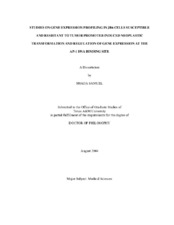| dc.contributor.advisor | Bernstein, Lori R. | |
| dc.creator | Samuel, Shaija | |
| dc.date.accessioned | 2005-11-01T15:45:12Z | |
| dc.date.available | 2005-11-01T15:45:12Z | |
| dc.date.created | 2004-08 | |
| dc.date.issued | 2005-11-01 | |
| dc.identifier.uri | https://hdl.handle.net/1969.1/2538 | |
| dc.description.abstract | Gene expression underlies all important biological processes in a cell and mis-regulated gene expression plays a causal or contributory role in several diseases including cancers. Towards identifying molecular determinants that confer susceptibility and resistance to tumor promoter induced neoplastic transformation, we analyzed the gene expression profile differences among tumor promoter TPA treated and untreated mouse epidermal JB6 cells by means of cDNA microarray analyses. The expression patterns for several genes were validated by real time PCR analyses. Seventy-four genes belonging to six functional categories were found to be differentially expressed. Data from this study implicate pathways which mediate cell adhesion, migration and interferon signalling, tumor suppressors, apoptotic proteins and transcription factors and includes twenty-six genes whose involvement has not been previously implicated in cancer.
In a second study we used a DNA affinity chromatography based assay to purify two proteins that bound specifically to the AP-1 DNA binding site. Analyses of the purified proteins by mass spectrometric sequencing determined the identities of these proteins as nucleolin and Y-box binding protein 1 (YB-1). We tested the hypothesis that these proteins regulate transactivation at the AP-1 site. Overexpression of nucleolin and YB-1, both alone or in combination, repressed AP-1 dependent gene transactivation. To understand the mechanism of transrepression, we analyzed whether nucleolin and/or YB-1 affected the levels and/or disrupted the intracellular localization of the AP-1 protein subunits. Western blot analyses of all the AP-1 subunits revealed that the levels of AP-1 were unaffected. Cell fractionation confirmed that the AP-1 levels were not altered in the nuclear or cytoplasmic compartments. We further tested the hypothesis that nucleolin and YB-1 repressed AP-1 transactivation by competing with AP-1 proteins for the AP-1 site. The results from this experiment were inconclusive and the precise mechanism of repression is currently under investigation. | en |
| dc.format.extent | 2980733 bytes | en |
| dc.format.medium | electronic | en |
| dc.format.mimetype | application/pdf | |
| dc.language.iso | en_US | |
| dc.publisher | Texas A&M University | |
| dc.subject | gene expression | en |
| dc.subject | neoplastic transformation | en |
| dc.subject | JB6 cells | en |
| dc.subject | AP-1 | en |
| dc.subject | Regulation of gene | en |
| dc.subject | Microarray | en |
| dc.title | Studies on gene expression profiling in JB6 cells susceptible and resistant to tumor promoter induced neoplastic transformation and regulation of gene expression at the AP-1 DNA binding site | en |
| dc.type | Book | en |
| dc.type | Thesis | en |
| thesis.degree.department | College of Medicine | en |
| thesis.degree.discipline | Medical Sciences | en |
| thesis.degree.grantor | Texas A&M University | en |
| thesis.degree.name | Doctor of Philosophy | en |
| thesis.degree.level | Doctoral | en |
| dc.contributor.committeeMember | Peterson, David O. | |
| dc.contributor.committeeMember | Leibowitz, Julian L. | |
| dc.contributor.committeeMember | Gordon, Julius A. | |
| dc.contributor.committeeMember | Chapkin, Robert S. | |
| dc.type.genre | Electronic Dissertation | en |
| dc.type.material | text | en |
| dc.format.digitalOrigin | born digital | en |


